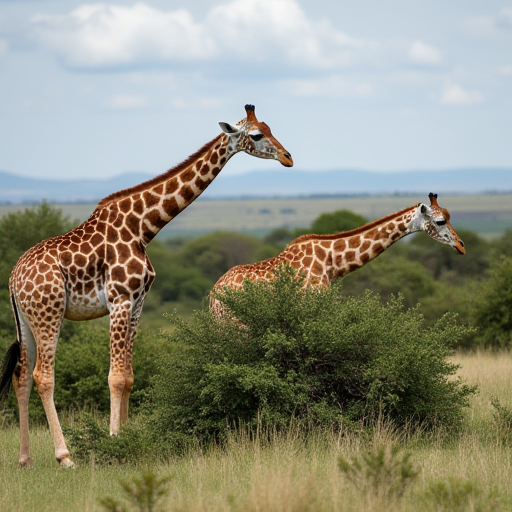
Why Do Giraffes Graze on Shrubs?
Giraffes, the tallest terrestrial animals, are distinguished by their elongated necks and legs, which allow them to access food sources unavailable to other herbivores. While it's common knowledge that giraffes feed on the leaves of tall trees, particularly acacias, they are also known to graze on shrubs. This feeding behavior may seem unusual given their anatomical advantages, but it serves several important ecological and nutritional purposes. This article explores the reasons behind this behavior, examining the dietary needs, ecological role, and adaptive strategies of giraffes.
The Dietary Needs of Giraffes
Giraffes are herbivores, primarily consuming plant-based materials. Their diet mainly consists of:
- Leaves: Particularly from acacia trees, which provide essential nutrients.
- Flowers: Offering additional nutrients and variety.
- Fruits: When available, they are a source of moisture and vitamins.
- Shrubs and Bushes: Supplementing their diet with essential minerals and nutrients.
Nutritional Requirements
Giraffes require a diet rich in calcium and phosphorus to support their massive skeletal structure. Additionally, they need adequate protein and other nutrients to maintain their energy levels and overall health. Shrubs can provide these necessary nutrients, especially when the primary food sources are scarce.
Ecological and Seasonal Considerations
Availability of Food Sources
Giraffes inhabit savannas, grasslands, and open woodlands in Africa, where food availability can vary greatly depending on the season and climate conditions. During dry seasons or droughts, when trees may not produce ample foliage, giraffes may turn to shrubs as an alternative food source. Shrubs are often more resilient to harsh environmental conditions, retaining moisture and nutrients that are crucial for survival.
Diversification of Diet
Grazing on shrubs allows giraffes to diversify their diet, which is beneficial for several reasons:
- Avoiding over-reliance on a single food source: This reduces the risk of malnutrition and starvation if that source becomes scarce.
- Reducing competition: Other herbivores, like elephants and antelopes, may also feed on acacia leaves, leading to competition. By including shrubs in their diet, giraffes can reduce this competition and ensure a more consistent food supply.
Adaptive Strategies
Anatomical and Behavioral Adaptations
Despite their height, giraffes are well-equipped to graze on shrubs. Their prehensile tongues, which can extend up to 18 inches, and flexible upper lips allow them to grasp and strip leaves from shrubs effectively. Their long necks, while advantageous for reaching high foliage, also enable them to reach down to access lower-growing plants.
Energy Conservation
Giraffes must manage their energy expenditure wisely. Grazing on shrubs, which are often found in denser patches than isolated tall trees, allows giraffes to consume significant amounts of food without having to move large distances. This energy conservation is especially important in harsh environmental conditions.
Ecological Role and Impact
Giraffes play a critical role in their ecosystem, and their grazing habits help maintain the health and balance of their environment:
- Promoting Plant Diversity: By feeding on a variety of plants, including shrubs, giraffes help maintain plant diversity, which is crucial for a resilient ecosystem.
- Seed Dispersal: As giraffes consume fruits and leaves, they aid in seed dispersal, contributing to plant propagation and growth.
- Habitat Maintenance: Their selective feeding can help control the growth of certain plant species, preventing overgrowth and maintaining open spaces for other animals.
Conclusion
Grazing on shrubs is a strategic behavior that allows giraffes to fulfill their dietary needs, adapt to environmental challenges, and play a vital role in their ecosystem. This behavior underscores the giraffe's adaptability and the intricate balance within their habitat. Understanding these dynamics helps us appreciate the complexity of giraffe ecology and the importance of conserving their natural environments to ensure their continued survival.
